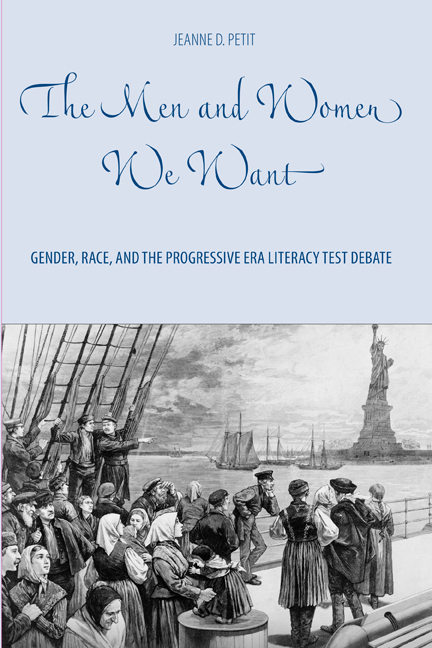Book contents
- Frontmatter
- Dedication
- Contents
- List of Illustrations
- Acknowledgments
- Introduction
- 1 Breeders, Workers, and Mothers: The Beginning of the Literacy Test Debate
- 2 Parents and Progeny: The Dillingham Commission Report
- 3 Muscle, Miscegenation, and Manhood: The Literacy Test at the Height of the Progressive Era
- 4 Practical Aid and Sympathetic Understanding: Grace Abbott's Alternative to the Literacy Test
- 5 World War I and the Literacy Test
- 6 The Legacy of the Progressive Era Literacy Test Debate
- Notes
- Bibliography
- Index
4 - Practical Aid and Sympathetic Understanding: Grace Abbott's Alternative to the Literacy Test
Published online by Cambridge University Press: 14 March 2018
- Frontmatter
- Dedication
- Contents
- List of Illustrations
- Acknowledgments
- Introduction
- 1 Breeders, Workers, and Mothers: The Beginning of the Literacy Test Debate
- 2 Parents and Progeny: The Dillingham Commission Report
- 3 Muscle, Miscegenation, and Manhood: The Literacy Test at the Height of the Progressive Era
- 4 Practical Aid and Sympathetic Understanding: Grace Abbott's Alternative to the Literacy Test
- 5 World War I and the Literacy Test
- 6 The Legacy of the Progressive Era Literacy Test Debate
- Notes
- Bibliography
- Index
Summary
When testifying against the Burnett literacy test bill in 1912, Grace Abbott refused to be baited. Everis Hayes, a California Republican and member of the House Immigration and Naturalization Committee, pushed Abbott to admit that the racial composition of immigration had changed, and not for the better. Abbott acknowledged that more immigrants had come from southeastern Europe, but she also challenged the notion that they were racially inferior. “Anyone who knows the family life of the newly arrived immigrant,” she claimed, “sees very little menace in the situation.” She spoke of the sacrifice young men and women made to save money and bring over relatives, and then concluded, “I have often wondered what the average American boy or girl could teach the foreign boys and girls in the matter of that fundamental Americanism—devotion to one's family.” For Abbott, proof of whether an immigrant was desirable was neither established in the manly conquest of a frontier nor in germ plasma that fathers passed on to sons. Instead, it emerged in the family and community, where men and women, husbands and wives, sons and daughters fulfilled their obligations to each other and to the larger society. A literacy test, she argued, was a false indicator of whether an immigrant could become a good citizen because it did not test whether immigrants could realize that “fundamental Americanism.”
It was not as though Grace Abbott devalued literacy. In fact, she promoted literacy as a positive good, much more so than the men of the Immigration Restriction League (IRL) or the American Association of Foreign Language Newspapers (AAFLN). In 1911, she, along with Jane Addams, wrote to Democratic Representative Oscar Underwood of Alabama, a restrictionist member of Congress, and acknowledged that education was desirable among the citizenry, and that “much could be said in favor of an educational test as a requisite for naturalization.” For Abbott, though, using literacy as a test for admission was an improper use of government resources and did not get to the root of the “immigrant problem.”
- Type
- Chapter
- Information
- The Men and Women We WantGender, Race, and the Progressive Era Literacy Test Debate, pp. 87 - 102Publisher: Boydell & BrewerPrint publication year: 2010

